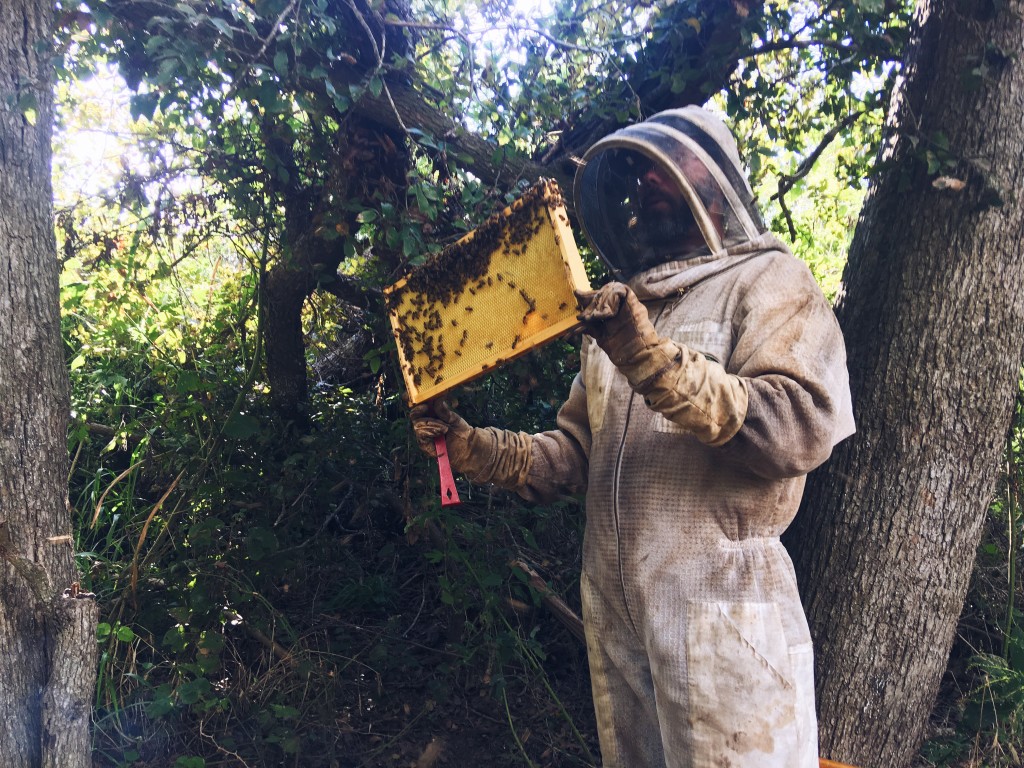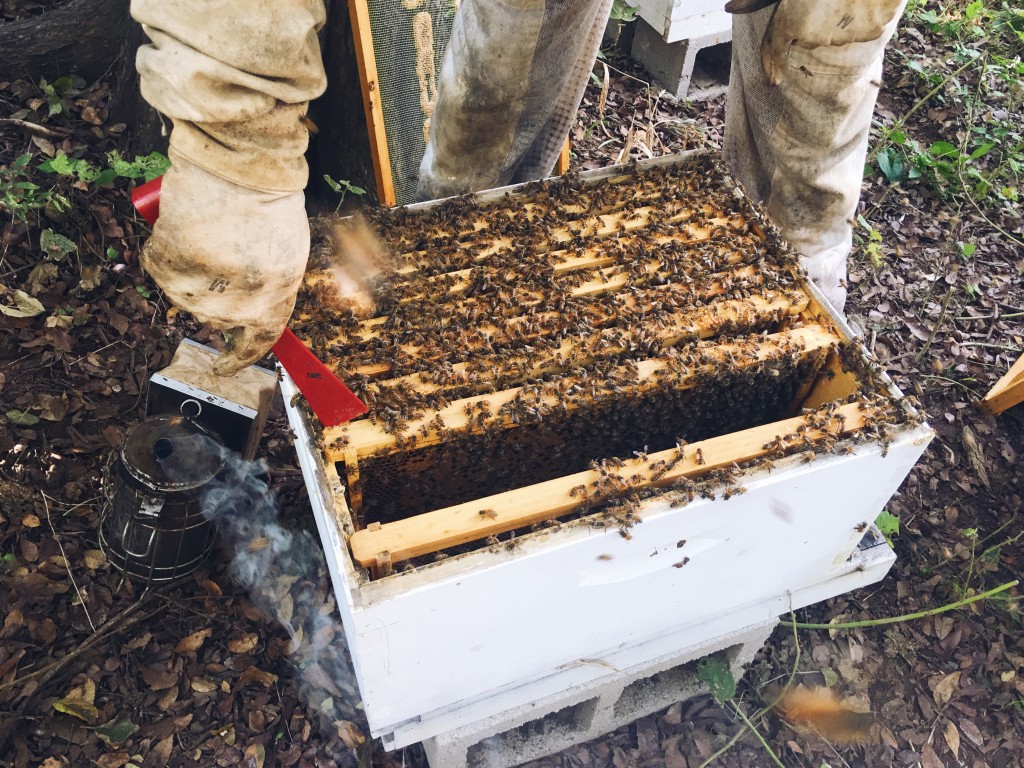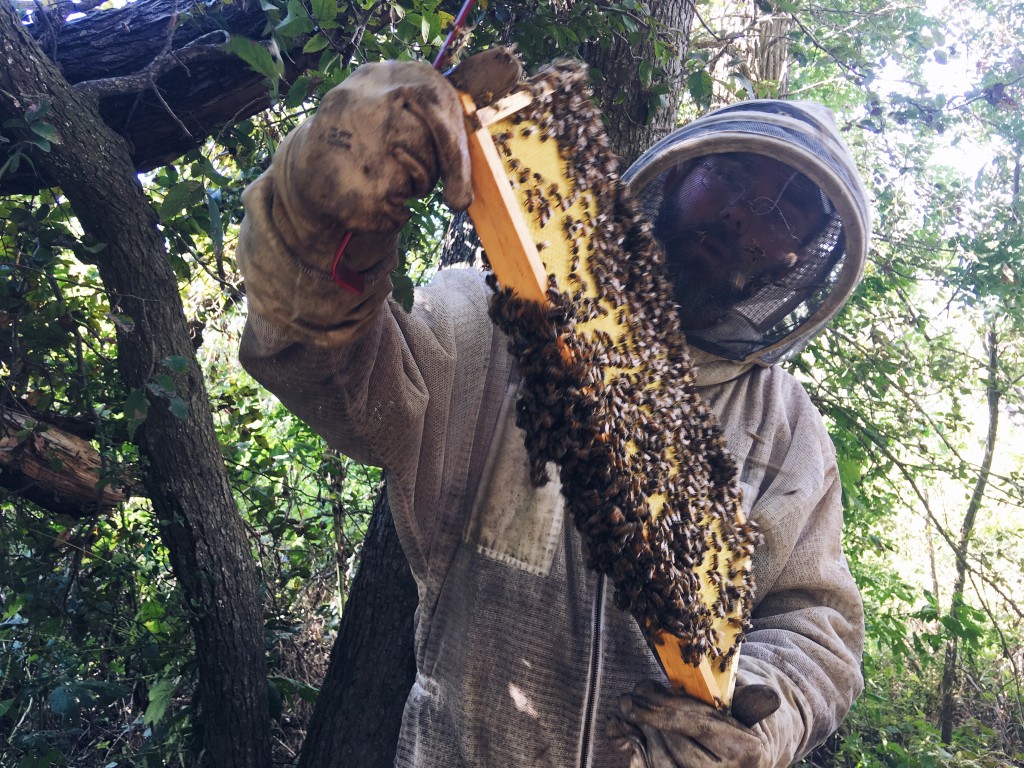
THE BUZZ ABOUT OUR BEES
10/21/16 — Heydon Hatcher
It’s hive time for a bee update, don’t you think? We briefly mentioned these hard-working winged ones and the folks who care for them on the blog back in July, but if you haven’t been following along… here’s an abridged history.
![Photo by Charlotte McClure.]() Photo by Charlotte McClure.
Photo by Charlotte McClure.
St. David’s Environmental Guild received a grant to place a couple beehives on their property earlier in the year; however, with zoning restrictions downtown, they needed to outsource their honeybees. Because of our CSA drop there and our inherent and constant need for large-scale pollination (200 acres warrants a whole lot of pollinating), they immediately thought of us as a fit host for their bees! We had one pre-existing hive, but were ecstatic at the prospect of having more as the benefits of having hives on the farm are numerous (boosts in vegetable yields, amelioration of overall produce quality, delectable and succulent honey, and helping preserve a quickly dwindling worldwide bee population to name a few). Thus bee-gan the grand honeybee adventure at JB[ee]G!
![Photo by Charlotte McClure.]() Photo by Charlotte McClure.
Photo by Charlotte McClure.
The hives are located in a grove of trees neighboring the Colorado River, so they have plenty of access to shade, water, and prolific organic fields to forage. Currently, our three hives are very healthy (albeit really aggressive), and set to produce loads of honey next year if the rain and nectar flow are sufficient and steady, according to the beekeepers. The bees are preparing for the more dormant winter months, sealing up honeycomb, and gathering around the queen to keep her warm on the cooler days ahead.
![Photo by Charlotte McClure.]() Photo by Charlotte McClure.
Photo by Charlotte McClure.
This week, the lead beekeeper, Jason Minnix, spearheaded an attempt to re-queen the colonies to ameliorate the rampant erratic and volatile bee-havior of two of the hives as the queen dictates the temperament of the rest of the bee population. He came by earlier this week with the new queens (fun fact: they arrive via mail in tiny wooden cages!), suited up and ready to start the meticulous task of finding and replacing the current reigning queens. Very important side note: if you don't remove a colony's old queen before introducing the new one, the hive may reject the new queen and kill her. On the first hive, Jason couldn’t find the queen after searching for an hour, but went ahead and put in the new queen. As said by Charlotte, our farm administrator, “looking for the queen bee among thousands of workers and drones [is] like a constantly moving Where's Waldo puzzle.” So in this situation, there is a 50/50 chance of them accepting or killing her… fingers crossed they keep her! On the second hive, the search was exponentially quicker… he placed the new queen in the colony after removing the old one successfully. All signs point to the bees accepting her! Let’s hope these new queens maintain a more peaceful vibe within the colonies.
We are over the moon to be working with St. David’s, and immensely grateful for all their marvellous and brave volunteers who care for the bees. Y’all bee-have until next time!
Don’t miss our CSA Members Only Potluck this Saturday, 10/22 at the farm! RSVP here. If you can’t make it Saturday, no problem! Slow Food Austin is hosting a farm tour on Sunday, 10/23, buy tickets here.
Was this our okra? We may never know, but speculating sure is fun. Regardless, our okra really is the bomb. Speaking of okra: the days are dwindling to get our favorite okra dish at Contigo!
 Photo by Charlotte McClure.
Photo by Charlotte McClure.
St. David’s Environmental Guild received a grant to place a couple beehives on their property earlier in the year; however, with zoning restrictions downtown, they needed to outsource their honeybees. Because of our CSA drop there and our inherent and constant need for large-scale pollination (200 acres warrants a whole lot of pollinating), they immediately thought of us as a fit host for their bees! We had one pre-existing hive, but were ecstatic at the prospect of having more as the benefits of having hives on the farm are numerous (boosts in vegetable yields, amelioration of overall produce quality, delectable and succulent honey, and helping preserve a quickly dwindling worldwide bee population to name a few). Thus bee-gan the grand honeybee adventure at JB[ee]G!
 Photo by Charlotte McClure.
Photo by Charlotte McClure.
The hives are located in a grove of trees neighboring the Colorado River, so they have plenty of access to shade, water, and prolific organic fields to forage. Currently, our three hives are very healthy (albeit really aggressive), and set to produce loads of honey next year if the rain and nectar flow are sufficient and steady, according to the beekeepers. The bees are preparing for the more dormant winter months, sealing up honeycomb, and gathering around the queen to keep her warm on the cooler days ahead.
 Photo by Charlotte McClure.
Photo by Charlotte McClure.
This week, the lead beekeeper, Jason Minnix, spearheaded an attempt to re-queen the colonies to ameliorate the rampant erratic and volatile bee-havior of two of the hives as the queen dictates the temperament of the rest of the bee population. He came by earlier this week with the new queens (fun fact: they arrive via mail in tiny wooden cages!), suited up and ready to start the meticulous task of finding and replacing the current reigning queens. Very important side note: if you don't remove a colony's old queen before introducing the new one, the hive may reject the new queen and kill her. On the first hive, Jason couldn’t find the queen after searching for an hour, but went ahead and put in the new queen. As said by Charlotte, our farm administrator, “looking for the queen bee among thousands of workers and drones [is] like a constantly moving Where's Waldo puzzle.” So in this situation, there is a 50/50 chance of them accepting or killing her… fingers crossed they keep her! On the second hive, the search was exponentially quicker… he placed the new queen in the colony after removing the old one successfully. All signs point to the bees accepting her! Let’s hope these new queens maintain a more peaceful vibe within the colonies.
We are over the moon to be working with St. David’s, and immensely grateful for all their marvellous and brave volunteers who care for the bees. Y’all bee-have until next time!
Don’t miss our CSA Members Only Potluck this Saturday, 10/22 at the farm! RSVP here. If you can’t make it Saturday, no problem! Slow Food Austin is hosting a farm tour on Sunday, 10/23, buy tickets here.
Was this our okra? We may never know, but speculating sure is fun. Regardless, our okra really is the bomb. Speaking of okra: the days are dwindling to get our favorite okra dish at Contigo!






 0 ITEMS IN CART
0 ITEMS IN CART 

